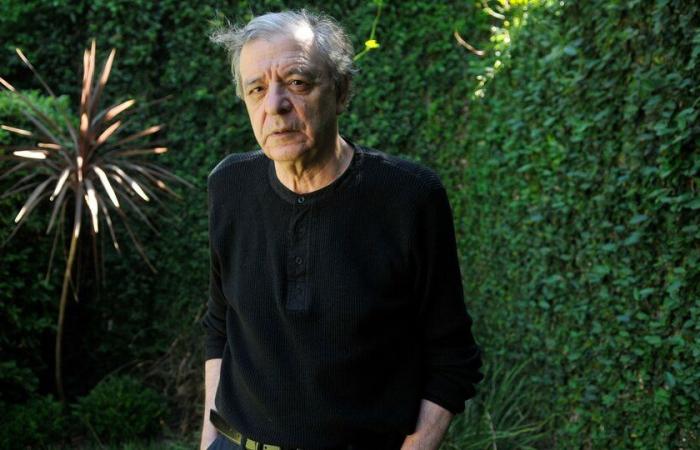A young man in his early thirties writes in an allusive and elusive style. He tries to capture the pulse of the violence of the 70s from a choral and fragmented narrative of strange crimes that recreate an oppressive atmosphere: “With what words can I explain the calamity of this moment; with what, the deaths; how to be able to equalize past duels with tears. The city falls collapsed. Corpses lie spread across the streets and houses and there are some who have gone to die on the religious thresholds of the temples.” Luis Gusmán, that young man who is now 80 years old, published his third novel, veiled body (1978) in the Corregidor publishing house, with the censorship on its heels. The civic-military dictatorship had banned it for “immoral” The bottle, his debut work, on January 24, 1977, the same day as the birthday of the author of the most untamed of the classics of Argentine literature. As if it were a kind of “missing” link, this rare, polyphonic, “plagiaristic” novel by Joseph Conrad had never been republished in the country until an artisanal literary publisher, No Shore, decided that the time had come to put it back together. On circulation.
Veiled body —which will be presented this Sunday at 6 p.m. at the Varela Varelita bar (Scalabrini Ortiz 2102) with the plastic artist Daniel Santoro, creator of the drawing that illustrates the cover of the new edition, and the writer Esther Cross, author of the prologue– could be read as the precursor to “There are corpses,” by Néstor Perlongher, a poem written in 1982 and published five years later in the book Wires. The editor of Nadie Orilla, Marcos Crotto, states that veiled body It was published when Gusmán’s incipient work was censored. “Luis wanted to expose the violence of the 70s. And at the same time, he had to outwit the censor. You had to go, then, into the depths, and there you went,” reflects the editor. “Gusmán recreates a city that mourns the death of a famous tango singer. In this atmosphere of collective mourning, different parallel and polyphonic stories develop with compressed anguish: there are strange crimes, spiritualists and sects, cemeteries and holidays to remember the dead. These stories written as if in phrases, like tangos that play on a nighttime radio whose unstable frequency is only heard by some solitary people, put together a mosaic, a journey towards the unconscious origin of the violence and despair that human beings can reach.”
In the postscript to this new edition, forty-six years later, the writer and psychoanalyst, who has been tracing one of the most important and original literary journeys in Argentina with works such as In the heart of June, The promised death, Virgil’s wheel, Frankie’s music, town, Tennessee, The calculated fiction, Hotel Eden, Not even dead have you lost your name, Epitaphs, the right to written death, The furrier, The dead don’t lie, Profane Hazelnut and I don’t want to say goodbyes, among others, reveals what it meant to reread his third novel. “Correction, that incorrigible obligation of the author, sometimes made me open my eyes in astonishment; and others, to close them, piously. To put it in ‘modernist’ terms, veiled body “It could be among the books that at some point Rubén Darío decided to call: ‘The weird ones’.”
The novel was only republished at the end of the 90s by the Casa de las Américas publishing house in Cuba. “In this edition I corrected some fragments that were indecipherable,” admits Gusmán. “It is not a historical novel even though it deals with the 70s. It was published in 1978, the year when, unavoidably and by my own decision, what was happening in the country entered my life forever. Today I am summoned by Chesterton’s phrase: ‘I believe that dignity has something to do with style.’ I said that it was a rare book, but it is not like that: I rarefied the novel to escape censorship, but not at the cost of giving up dignity or style,” he clarifies to Page 12.
In the prehistory of veiled bodyRicardo Piglia, Juan Carlos Martini Real, Germán García and Gusmán himself, who met at the Martín Fierro bookstore, where the author of The bottlethey decided to write a joint novel under the slogan of building the plot from reading a day’s diary. “This idea of reading the newspapers on a Sunday occurred to Piglia, and just that Sunday (November 2, 1975) (Pier Paolo) Pasolini died,” the writer recalls. “I was with (James) Joyce in my head and the remains that are cremated in the mass grave if the relatives do not take care of them, according to an obituary notice that he had read. “That person who appeared in the notice was talking about an Irish relative,” he adds and specifies that the novels written by several people have “very strong” literary antecedents.
“Chesterton and Agatha Christie, who formed he Detection club, they write the novel The floating admiral. In our time it was the other way around: those who had that military rank were the ones who made the corpses float,” Gusmán compares and points out that the other way of writing among several was the procedure carried out by the surrealists. “A text was written on a napkin and passed from hand to hand and thus what was called ‘exquisite corpse’ was created. Without a doubt, two disgusting words if one contextualizes them at that time. We had no idea what we started and it never prospered,” the writer reviews.
-What was it like writing “Cuerpo veiled” in the midst of a civil-military dictatorship? What precautions did you take so that the novel did not end up banned like “El frasquito”?
-We managed with an allusive and elusive style. At that time with Germán García and Osvaldo Lamborghini in the magazine Literal We raised the discussion from an ectopic place because the magazine never had a marginal space but rather positioned itself as a point of reference for the issues that were discussed following the policy of writing between the lines.
-“Brillos”, your second novel, you wrote against “El frasquito” because you didn’t want to do “El frasquito II”. What happened to “Veiled Body”?
-I had never thought of the title of veiled body by the passage from light to darkness. I always planned to write this book secretly as a way to intervene between the lines and escape the real censorship that was effectively exercised. He suffered it on the spot; In fact, they banned the book from the same bookstore where I worked. Veiled I also thought of it because of the bodies that were not veiled… In another direction, for me a cruder writing was left behind and certain baroque veils appeared that are already in Shines, but the latter as part of my own invention; the tropisms of a corpus literary advance, recede or coagulate.
–Ever you commented that with “Veiled Body” a series ends of novels in which the voice has capitulated. In what sense did the voice capitulate?
-My first resource was to use that attenuated form of plagiarism, collage; There are fragments from different authors that I copied as long as they agreed with my writing. veiled body ends with a sentence from the novel In the heart of darkness (by Joseph Conrad): “The horror, Ah the horror!” Marlow’s character going all the way across the river to find Kurtz when she finally spots him with his spyglass reverses this. That is, she distances herself from horror. In the dictatorship there was no distance from horror. Perhaps today the spyglass has been reversed again.






